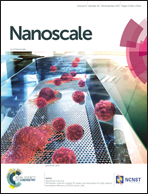Vertically stacked nanocellulose tactile sensor†
Abstract
Paper-based electronic devices are attracting considerable attention, because the paper platform has unique attributes such as flexibility and eco-friendliness. Here we report on what is claimed to be the firstly fully integrated vertically-stacked nanocellulose-based tactile sensor, which is capable of simultaneously sensing temperature and pressure. The pressure and temperature sensors are operated using different principles and are stacked vertically, thereby minimizing the interference effect. For the pressure sensor, which utilizes the piezoresistance principle under pressure, the conducting electrode was inkjet printed on the TEMPO-oxidized-nanocellulose patterned with micro-sized pyramids, and the counter electrode was placed on the nanocellulose film. The pressure sensor has a high sensitivity over a wide range (500 Pa–3 kPa) and a high durability of 104 loading/unloading cycles. The temperature sensor combines various materials such as poly(3,4-ethylenedioxythiophene)–poly(styrenesulfonate) (PEDOT:PSS), silver nanoparticles (AgNPs) and carbon nanotubes (CNTs) to form a thermocouple on the upper nanocellulose layer. The thermoelectric-based temperature sensors generate a thermoelectric voltage output of 1.7 mV for a temperature difference of 125 K. Our 5 × 5 tactile sensor arrays show a fast response, negligible interference, and durable sensing performance.



 Please wait while we load your content...
Please wait while we load your content...